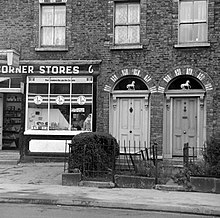Cultural depictions of William III of England
This article appears to contain trivial, minor, or unrelated references to popular culture. (October 2016) |
This article needs additional citations for verification. (October 2016) |
Ballads[]
Copies of extant seventeenth-century broadside ballads about William III and Mary II, such as "England's Triumph", "England's Happiness in the Crowning of William and Mary", "A new loyal song, upon King William's Progress into Ireland" and "Royal Courage, King William's Happy Success in Ireland", are housed in Magdalene College's Pepys Library, the National Library of Scotland, and the British Library.[1]
Art[]

In Dublin city, the display of a white plasterwork horse in the fanlight of a door was believed to denote a household that was Protestant and loyal to the United Kingdom. The horse was a depiction of William's white horse, which he rode during the Battle of Boyne.[2][3]
In London, an equestrian bronze of the King is to be found in St. James's Square.
Literature[]
- Marjorie Bowen wrote three historical novels about William's life. They are I Will Maintain (1910), Defender of the Faith (1911), and God and the King (1911).[4]
Film[]
- William III of England has been played on screen by Bernard Lee in the 1937 film The Black Tulip, based on the novel by Alexandre Dumas, père.
- Henry Daniell in the 1945 film Captain Kidd.
- Olaf Hytten in the 1952 film Against All Flags.
- Thom Hoffman in the 1992 film Orlando, based on the novel by Virginia Woolf.
- Corin Redgrave in the 1995 film England, My England, the story of the composer Henry Purcell.
- Bernard Hill in the 2005 film The League of Gentlemen's Apocalypse.
- in the 2015 film Michiel de Ruyter.
Television[]
- Alan Rowe in the 1969 BBC drama series The First Churchills.
- Laurence Olivier in the 1986 NBC TV mini-series Peter the Great.
- Jochum ten Haaf in the 2003 BBC miniseries Charles II: The Power & the Passion.
- George Webster in Versailles (2015).
Theatre[]
- Carl Prekopp in the 2015 premiere of the play Queen Anne.
References[]
- ^ English Broadside Ballad Archive. "Broadside Ballads About King William". English Broadside Ballad Archive. University of California at Santa Barbara, Department of English. Retrieved 20 September 2014.
- ^ Nuttall, Deirdre; MacCarthaigh, Críostóir (25 August 2017). "A 'Protestant folk'? Addressing a historical imbalance in Irish folklore-collecting". History Ireland. 25 (5). Retrieved 31 August 2021.
- ^ Cheng, Vincent J. (1991). "White Horse, Dark Horse: Joyce's Allhorse of Another Color". Joyce Studies Annual. 2: 101–128. ISSN 1049-0809. Retrieved 31 August 2021.
- ^ F. Seymour Smith, What Shall I Read Next? A Personal Selection of Twentieth Century English Books. Cambridge, Cambridge University Press, 2010. ISBN 0521064929, (p.95)
- Cultural depictions of William III of England
- Cultural depictions of English kings
- Cultural depictions of Scottish kings